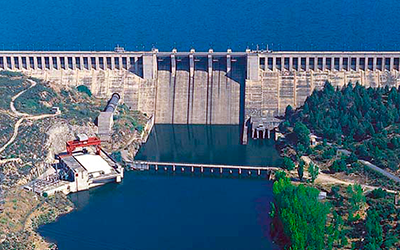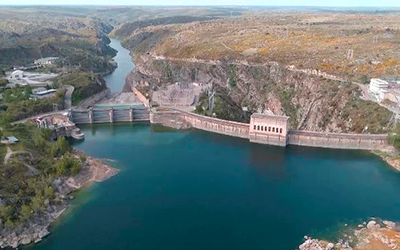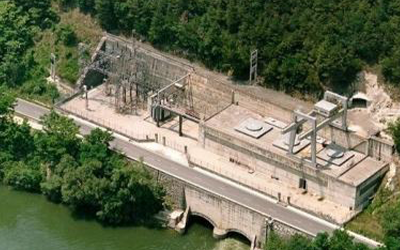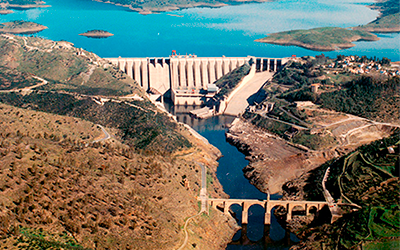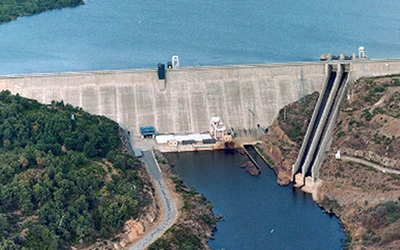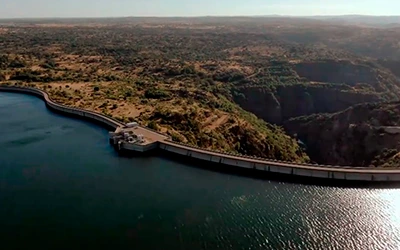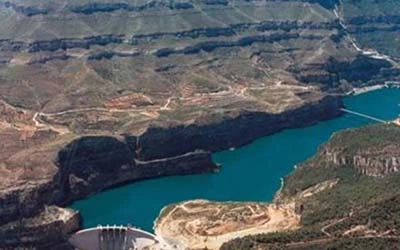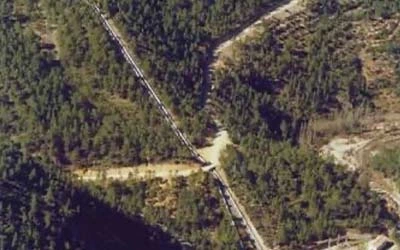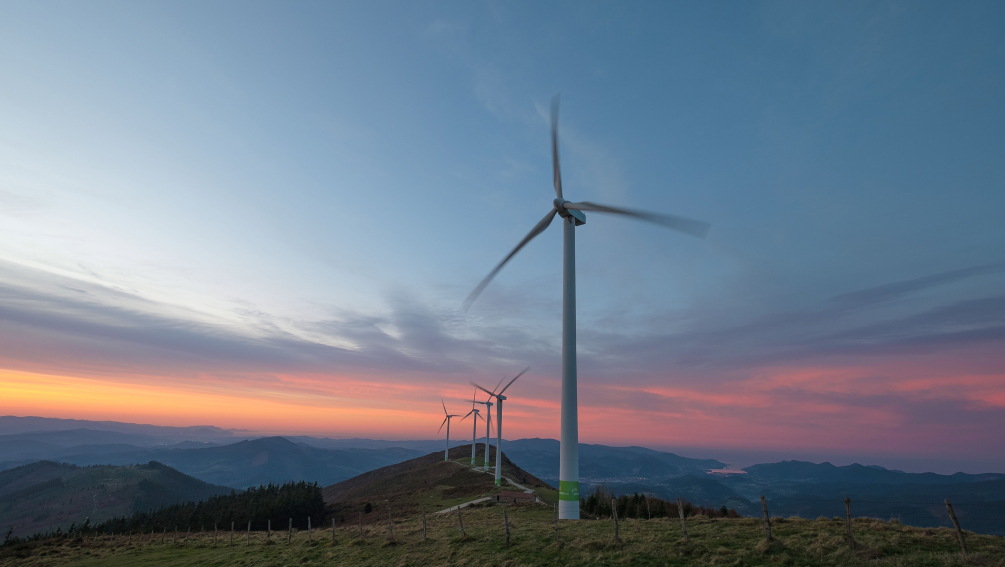EBRO-CANTABRIAN BASIN: OUR HYDROELECTRIC POWER STATIONS
Iberdrola España operates more than twenty hydroelectric power plants in the Ebro-Cantabrian River Basin
The Ebro River Basin is the largest in the country, stretching from the Cantabrian Mountains to its mouth at the Mediterranean Sea. It also occupies 17% of the Spanish peninsular territory and is one of the main basins in Europe. Iberdrola España operates 22 hydroelectric plants in the Ebro-Cantabrian River Basin, with an installed capacity of 54 MW. All these facilities are located in Navarre, La Rioja, the Basque Country and Castile-León.
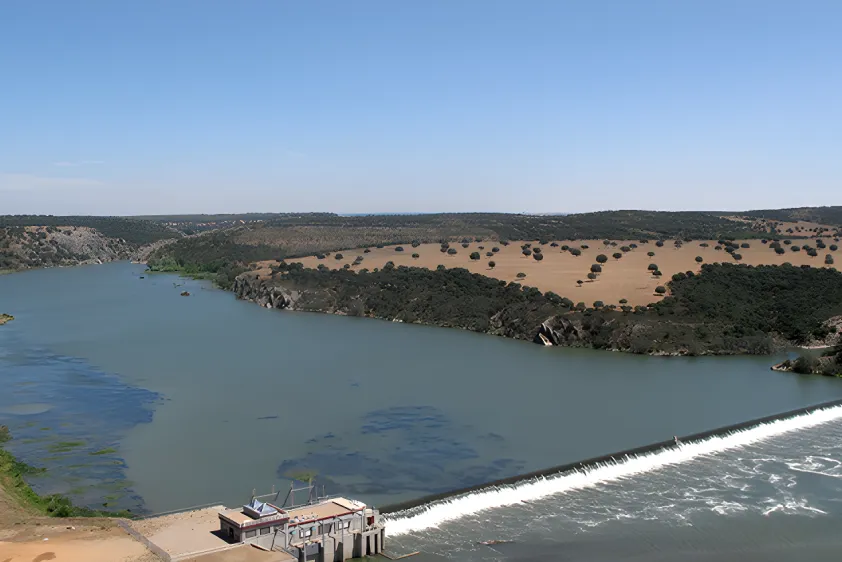
HYDROELECTRIC PLANTS IN THE SEGURA BASIN




The Ebro River, with a length of 930 km and an average flow of 600 m3/S, holds the title of being the longest river in Spain and the second longest in the Iberian Peninsula. The Ebro basin is the largest in Spain and is one of the main European Mediterranean basins. It occupies a total surface area of 85,534 km2. Its limits extend from the Cantabrian Mountains and the Pyrenees to the Catalan-Coastal chain, according to the Ebro River Basin Authority (Confederación Hidrográfica del Ebro).
Iberdrola España has a presence in the Ebro-Cantabrian River Basin through more than twenty facilities, with a total installed capacity of 54 MW, which is sufficient to directly supply around 37,800 households in Spain.
Ebro-Cantabrian reservoirs
El Cortijo Reservoir
Located in the municipality of Oyón, in Logroño, the El Cortijo reservoir dam was built in 1922. The reservoir is a gravity dam with a height of 10.10 metres and covers a basin area of 10,365 km2.
Upper and Lower Leurtza Reservoir (Urroz)
At the beginning of the 20th century, in 1920, the two Leurtza reservoirs were built, between the municipalities of Urrotz and Beintza-Labaien, with the aim of generating electricity. This task is carried out by means of a pressure pipe that, in a short distance, exceeds a 250-metre drop and supplies energy to a power station located downstream.
The construction of Upper and Lower Leurtza required an access road from Urrotz, which has been paved since the 1980s. In addition, a quarry was set up to extract stone, the remains of which can still be seen on the right bank of the lower reservoir. The Leurtza reservoirs are not only large infrastructures for the production of electricity, but have also been declared a Natural Recreational Area. The dams of both reservoirs are each 23 metres high and are gravity dams. Their surface area varies: the Upper Leurtza dam covers 2 hectares, while the Lower Leurtza dam covers 6 hectares.
Hydroelectric power plants of the Ebro-Cantabrian basin
The Ebro-Cantabrian basin is home to some twenty hydroelectric power plants that harness the region's river network to generate renewable electricity. These facilities play a crucial role in the stability of the regional electricity supply, the management of water resources and the mitigation of carbon emissions, becoming fundamental pillars of energy and environmental sustainability in the northern part of the country.
Anguiano
The Anguiano hydroelectric power station has been producing electricity for more than a century thanks to its three turbines, commissioned in 1921. The facility, located between the municipalities of Anguiano and Brieva de Cameros, uses water from the river Najerilla, which is collected at a dam five kilometres away. From there, it is channelled through a canal that reaches a reservoir built in the mountains and flows into the plant, with a waterfall of more than 68 metres. The facility has an installed capacity of 3.48 MW.
Arrambide
Located on the river Urumea, in the towns of Goizueta and Arano, the Arrambide hydroelectric power station has been generating hydroelectric power since 1901. With a head of 39.7 metres, it has an installed capacity of 1.08 MW.
Judgment
The Buicio hydroelectric power station is located in Fuenmayor (La Rioja) and was commissioned in 1996. The hydroelectric power plant has a head of more than 3 metres and has an installed capacity of 2.12 MW.
La Arboleda
The La Arboleda outdoor power plant, located in Miranda de Ebro (Burgos), began operating in 1999. It has a waterfall of 2.4 metres and an installed capacity of 1.2 megawatts.
Labastida
The Labastida hydroelectric power station, in the municipality of the same name in Álava (Basque Country), was commissioned in 1999. The facility generates electricity thanks to its 3.38 MW of installed capacity.
Las Cuevas
In the town of Anguiano, in La Rioja, is the Las Cuevas hydroelectric power station, which came into operation in 1953. It has a waterfall of 21.5 metres and an installed capacity of 1.84 MW.
Las Norias
The Las Norias hydroelectric power station in Logroño has an installed capacity of 1.92 MW and a head of 4.2 metres.
Leiza
Leiza, between the towns of Ezcurra and Leiza, in Navarre, is a hydroelectric power station that has been active since 1925. It operates with a head of 197 metres and an installed capacity of 1.70 MW, providing electricity to around 700 homes.
Leizarán
The Leizarán hydroelectric power station has become an important facility in the Basque Country, being the most powerful in the whole of Guipúzcoa and highly frequented by hikers in the area. This facility, commissioned in 1907 and located in the municipality of Andoain, has a head of 209 metres and an installed capacity of 3.6 MW.
Najerilla
The Najerilla hydroelectric power station has been located in the municipality of Anjiano, La Rioja, since 1965. It operates with a waterfall almost 30 metres high and an installed capacity of 2.42 MW, which provides electricity to 1,694 homes.
Oiz
The Oiz hydroelectric power station was commissioned in 1925 and is located on the river Leurtza, between the towns of Urroz de Santesteban and Oiz, in Navarre. Its 1.12 MW of installed capacity generates renewable energy capable of benefiting some 700 homes and takes advantage of a 156-metre high waterfall.
Panzares
At the foot of the N-111 road, between the municipalities of Castañares de las Cuevas and Panzares de Viguera, is the Panzares hydroelectric power station. The facility was commissioned in 1906, taking advantage of a 61.5 metre high waterfall in the River Iregua. During this time in operation, 4 cubic metres of water per second have been accounted for, with an installed capacity of 2.42 MW.
San Tiburcio
The San Tiburcio hydroelectric facility, located on the river Bidasoa, came into operation in 1955. Located between the towns of Santesteban and Sumbilla, it has a waterfall almost 18 metres high and an installed capacity of 1.36 MW.
St Vincent
The San Vicente hydroelectric power station in the municipality of S. Vicente de la Sonsierra (La Rioja) has been in operation for more than a century since it was commissioned in 1991. The facility takes advantage of a 3.32 metre high waterfall and has an installed capacity of 2.06 MW.
Santiago Urumea
The Santiago Urumea hydroelectric power station in Hernani (Guipúzcoa) has been in operation since 1900, at the beginning of the 20th century. The hydroelectric facility takes advantage of a 19.55 metre high waterfall to generate electricity, with an installed capacity of 1.14 MW.
Urroz
The Urroz hydroelectric power station is located on the river Leurtza, in the district of Santesteban. Since it was commissioned in 1920, the facility has taken advantage of the 343-metre high waterfall and provides electricity to 672 homes, thanks to its 0.96 MW of installed capacity.
Ventas de Yanci
The Ventas de Yanci hydroelectric power station harnesses the waters of the river Bidasoa to supply electricity to homes in the area. In operation since 1927 in Navarre, the hydroelectric plant has an installed capacity of 2.36 MW and a head of 40.84 metres.
Zubieta
Located in the municipality of Zubieta, the hydroelectric power station of the same name has been in operation since 1906. The facility takes advantage of a 91-metre high waterfall in the Ezkurra river to generate electricity with an installed capacity of 0.78 MW.
Zumarresta
The Zumarresta hydroelectric facility, in the Navarre municipality of Ezcurra, harnesses the waters of several streams in the municipality of Arano. The plant has a 182-metre high waterfall and an installed capacity of 4.02 MW, capable of supplying electricity to 2,618 homes.
Viniegra (Piarrejas)
WiLocated in Viniegra de Abajo and the Mancomunidad de Municipios de Canales de la Sierra, Mansilla and Villavelayos (La Rioja), the Viniegra (Piarrejas) hydroelectric power station supplies electricity to 840 households. The facility has an installed capacity of 1.18 MW and a head of 12 metres. th an installed power of 4.80 MW, this mini-power station has been benefiting 3,360 families a year since it was commissioned in 1955. It is located in the municipality of Ayna, in Albacete, and has a 105-metre drop.
El Cortijo
Located in Logroño, the El Cortijo hydroelectric power station, commissioned in 1918. The height of the fall is 15.1 metres and its installed capacity is 7.79 MW.
Mansilla
The Mansilla hydroelectric power station, located in the municipality of the same name in La Rioja, has been generating electricity from a 70-metre high waterfall since 1969. The facility has an installed capacity of 5.76 MW.
